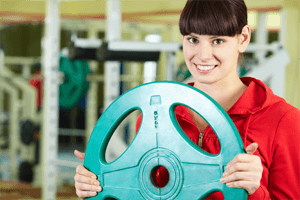Prescribing effective core training is an important part of program design. This is especially true for the postnatal women on your roster. These postnatal women might say they're striving to "get their abs back," but what that really means is regaining their core strength, getting rid of low back pain, and developing a pelvic floor that doesn't leak.
Your core training after pregnancy must be strategic. You must understand Diastasis Recti (DR), the importance of coaching your ladies to proper alignment, what abdominal exercises are safe, and which ones are not.
Here's what we know so far:
- Crunches, sit-ups, planks, jackknifes and the like aren't effective core training exercises to be doing early on after pregancy (or potentially, ever!). These exercises aren't "healing-promoting" for DR and will likely cause more harm than good for postnatal women.
- Your clients need to re-train their deep core musculature to fire properly again before we attempt to strengthen.
- Your clients likely need to practice realigning their bodies on a daily basis and during exercise.
 However, often clients get bored of the transverse contractions, dead bugs, breathing, and baby side planks. They keep asking you when the front planks, v-sits, push-ups, and knee tucks can be added back into their workout mix.
However, often clients get bored of the transverse contractions, dead bugs, breathing, and baby side planks. They keep asking you when the front planks, v-sits, push-ups, and knee tucks can be added back into their workout mix.
They want to know when they can start "real" core training again -- I get it! It can be hard to reign your clients in and keep drilling the basics for months and months.
First, it's important to communicate to your clients that often the best core training exercises are ones that perhaps don't look like they're training the "abs."
Explain to your ladies that so many of the full-body exercises you're programming overlap into core training, that you don't need a considerable emphasis on training the "abs" to achieve good core stability and a flat after pregnancy stomach.
Your postpartum women will need some specific core exercises when you're healing a diastasis and correcting alignment, but full body exercises, especially those recruiting the glutes and upper back can take care of much of this for us.
Remember the importance of training the backside of the body and ensure you're spending additional focus training the glutes, hamstrings, rear delts, rhomboids, lats, and erectors.
How healed does a DR need to be before you can get to the "fun" stuff? Do you need to hit a specific finger gap width to be healed before your clients can plank again?
The short answer? No, you don't have to hit a specific finger gap to be healed. The longer answer? It should be be your goal to get your ladies to having connective tissue that can generate tension along the line alba. A fully closed gap is absolutely doable, but not necessary and doesn't guarantee your client to have a strong and stable core.
Some of the women I train who demonstrate great core stability and no lingering chronic pain have some gap remaining. That being said, if you're measuring a 5-6 finger width gap at any point along the linea alba, I would guess that your client isn't incredibly stable through the core.
The proof is in the connective tissue
Let's say your client presents with a 3-finger wide DR. We need to get deeper into the issue, literally. What you need to pay extra attention to is the quality of the connective tissue in the gap. Is it super soft and squishy? Is it rock hard?
If there's a slight gap remaining (2-3 fingers), yet the connective tissue feels solid and strong, I'm going to be far less concerned than a slight gap with connective tissue I can push inches into.
Crunches and sit-ups
For my clients, crunches and sit-ups aren't part of my core training repertoire. At this stage in the game, there are exercises that can accomplish my clients' goals more effectively than making a mom who holds a baby for 18 hours a day lie on the floor and crunch away. There are plenty more "bang for your buck" abdominal exercises for a diastasis or closed gap tummies.
Crunches and sit-ups can be furthering that bulge in the belly. Just consider that every time your client crunches up, their belly is probably popping up. Those muscles are creating a dome-like shape with every forced forward flexion. If you're performing exercises that cause the belly to bulge, you're essentially training the belly to bulge. Not exactly what your clients are hoping for.
I'm not comfortable programming these exercises when there are so many variations of abdominal training exercises that are more effective for getting the inner core unit firing and putting your clients' bodies into mom-friendlier positions. Hello nursing and baby carrying posture!

Planks and prone
Front planks and other exercises where the belly is hanging towards the ground are great exercises for core engagement. The catch? They're only so great when the abdominals can fire against that force and resist gravity.
Does your client feel like they're "falling out the front" of their stomach when performing these exercises? Do they feel like their abs are just hanging out and not contracting? Perhaps it's not quite time to add these variations back in, or you need to regress the exercise down to a more manageable level.
Jackknifes and knee tucks
There's value in these types of exercises that typically fall into the "hip flexion with neutral spine" category, meaning your client will practice tall posture through the spine while flexing at the hip. These types of exercises can be fantastic full body exercises.
Caution: head back to point #2. Are they bulging? Are they feeling pain or soreness in the lower back? Is there pressure in the pelvic floor that makes them want to run to the washroom? If they answered yes to any of these questions, they're not ready yet and that's okay!
What if they do seem ready to advance though? Fantastic! Here's what you're looking for:
- The connective feels strong and taut.
- Their belly isn't bulging out on exercises -- they feel like they can brace their abdominals effectively.
- They're not experiencing lower back or pelvic pain after exercising.
- They're not experiencing any pelvic floor incontinence, pelvic organ prolapse or pelvic floor dysfunction.
- They body is shaking or trembling excessively during exercises.
These are just some of the ways to gauge if your client is ready to start more advanced postpartum abdominal exercises. Use your best judgment and get comfortable having the sometimes "uncomfortable" conversations with your client.
My best advice? Sometimes you need to just try it. Try an exercise, see how it goes, and adjust accordingly.
---
For advice on training pregnant women, go to:
https://www.theptdc.com/exercising-while-pregnant-prenatal-training-advice-for-personal-trainers/
For information on Diastasis Recti (DR), go to:
https://www.theptdc.com/the-personal-trainers-guide-to-diastasis-recti/










